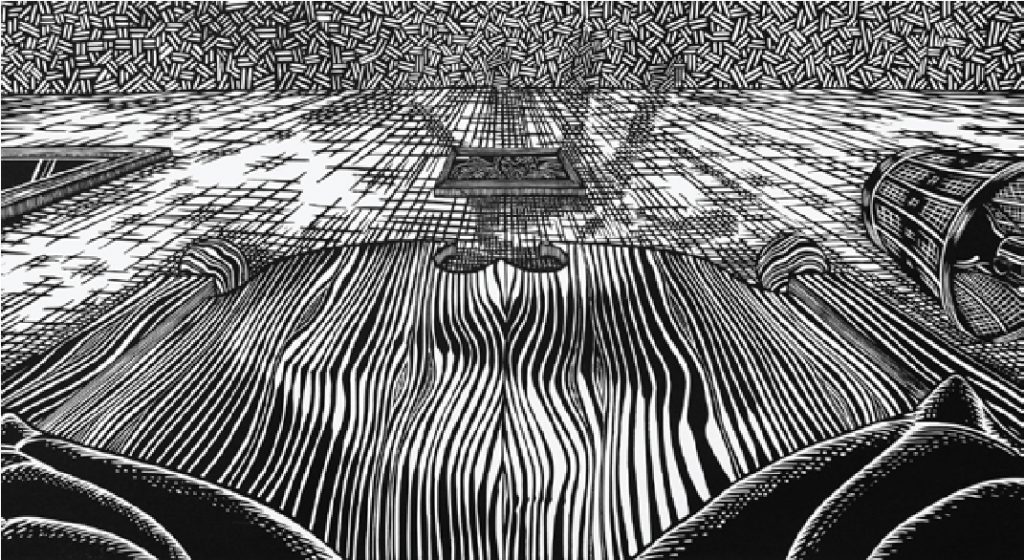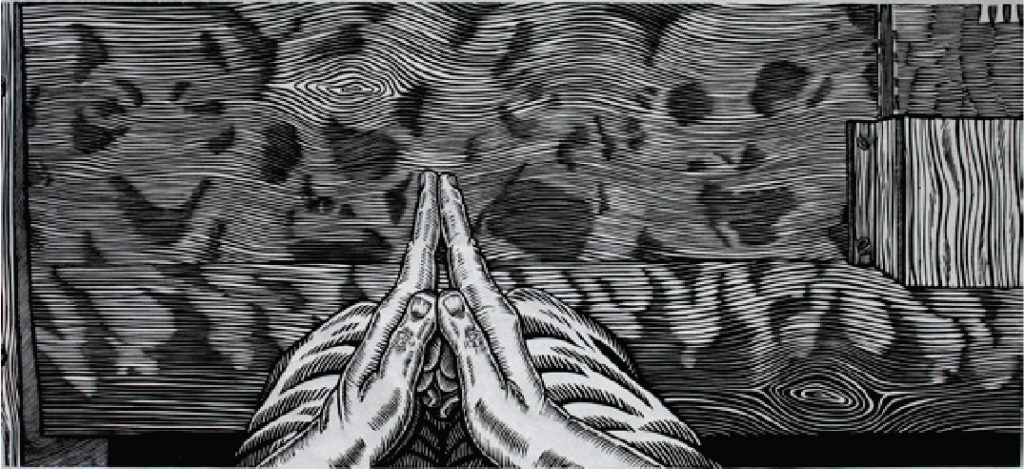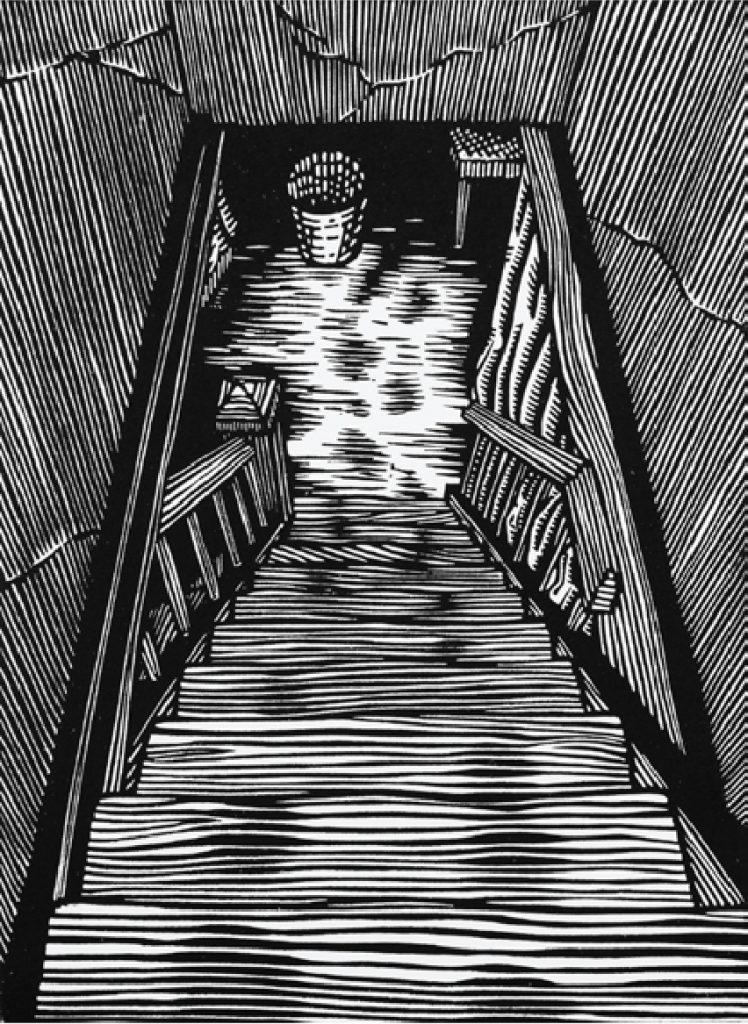Erich Neitzke was born in Mt. Prospect, Illinois in 1979. He received his Bachelor of Fine Arts with a minor in art history from Northern Illinois University in 2003. Before going back to school for his Master of Fine Arts, he spent a year in Paducah Kentucky, living in the Lower Town District as a part of the art community. After a year he returned to school and received his Master of Fine Arts from Southern Illinois University Carbondale in 2011 with an emphasis in printmaking. He participates in national juried exhibitions, has organized international print exchanges, and print shows. Additionally, he has taught a variety of classes at SUNY Potsdam and St. Lawrence University in New York. He is currently working and living in Brookport, Illinois.

Along the Baseboard
What originally made you interested in print making?
Growing up, I wanted to be a comic book artist and work with independent comic book publishers who produced the black and white “underground comics”. I learned about how pages were drawn and laid out by comic book artists and became very fascinated with this process. This was long before things were done digitally. Artists would layout, pencil in and then ink their images. Text was often cut and pasted directly into the drawings. Corrections were made; sometimes pre-printed values ranges were added in, etc. The process of printing these images would remove all the inconsistencies and unify all the bits into a (usually) seamless image. I was always trying to achieve this look with my drawings but I could never get this aesthetic I saw in the printed image. It lacked the step that “transformed” the image, like the process of a printed page.
When I discovered printmaking, particularly relief printmaking, I found that these processes could give me that “graphic” aesthetic I wanted for my images. They transformed the image and gave that step I was in search of.

Deadboard
You work a lot with linocut, why do you prefer this over other printmaking processes?
Aside from the aesthetic of the image, I really enjoy physical nature of creating linocuts and other relief cuts. Drawing out the image on the block and directly cutting out the image with the cutting tools gives me more control over the final image. Since I’m cutting out a three-dimensional image, there is a sculptural element to it as well.
What are you currently working on?
I’m currently working on a series of linocuts exploring the concept of “hauntings”. I’m interested in how we perceive an unseen “presence” through the way we interpret certain pieces of information. I’m exploring how the human mind can take these bits of information and reassemble it into a perceived whole. I’m creating images with forms that can be interpreted as figures or portions of figures, but yet are not totally defined. This leaves the viewer with questions about what may or may not be there, just like a haunting.
You work a lot with haunted/ scary subject matter. Why did you become interested in this subject?
I’ve always had an active morbid curiosity. I’m not sure when it started, but it’s always been there as far back as I can remember. Stemming from this, I’m also long time fan of the horror industry: movies, music, etc, which has had an impact on my work. While causing fear can be one of the goals of horror, it’s also a method of exploring topics that can cause us fear. For example, many feel frightened when confronted with a haunting. This is because if we are faced with activity or a presence that has no ready explanation. It can be disorientating and cause us anxiety and fear because it’s not we feel we can control or affect. I think it can also touch on knowledge of one’s own mortality and questions surrounding death. Exploring this through Horror can be a way of discussing these ideas.
Is there something you would like to experiment with in the near-future?
I’ve recently been working with a haunted theme park and I’ve been learning about practical special effects. I’m working on a way that I can integrate some of these techniques into my own work. It’s only in the very early planning stages but I think I should have something going in the next 2 years, maybe earlier.
Why did you decide to teach art?
Teaching art is very important because so many artists share similar experiences with the creative process, that it can be very beneficial to share these experiences with students to help them realize their goals. I also find teaching to be very fulfilling to pass on the techniques that have been passed on to me and to help introduce students to the wider art world.

Church In Hell

In the Shadow of Your Tread
Do you have any advice for MFA students entering the art world?
Get involved with the art world ASAP. Enter as many exhibitions as you can and get involved with whatever you can as much as possible. Having a career as an artist is a lifestyle and not a 9-5 job. Be prepared to do it from the moment you wake up, until you go to sleep everyday of the week for almost the rest of your life.
What advice do you have for approaching galleries?
Get to know the galleries you want to work with thoroughly. Check out the other artists they represent and see what you may have in common with them, but also what makes you stand apart.
Where do you look to find shows?
Primarily, I have found many shows through online printmaking organizations and tip-offs by other printmakers. Printmaking is a community and printmakers will often pass along information to each other. I also check the websites of both local, national and international art communities for shows as well.
Do you think the location an artist is living and working in plays a large role in how successful they can be?
In my own experience, not really. I personally know of a couple of successful artists who live in more remote and rural areas. They create their work; ship it out to shows, their galleries and travel to events. This is also because they found the areas they are working in to be the most conducive to their creative process. I think that’s very important. It maybe easier to be engage art in the places where it’s currently centered. But if one’s location somehow hinders their work, I don’t think it’s always worth the trade off.

Disquiet Path
Discover more artists at www.exposeartmagazine.com


